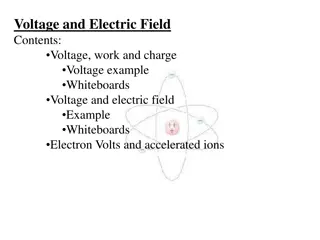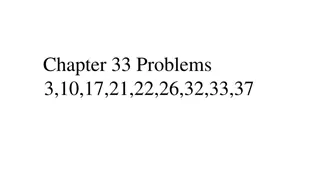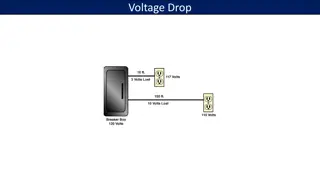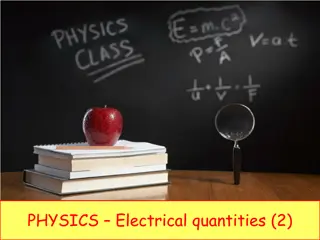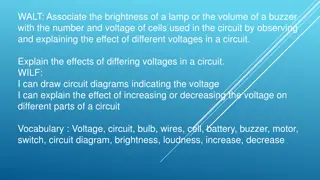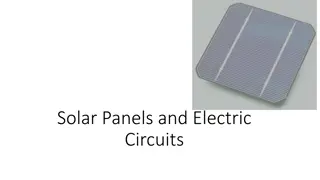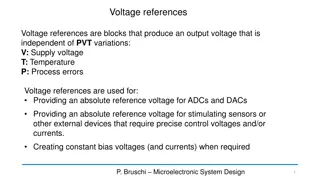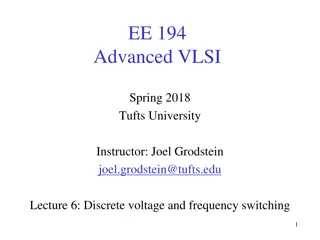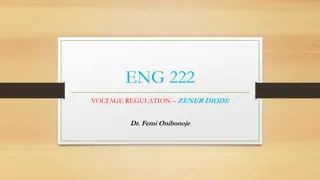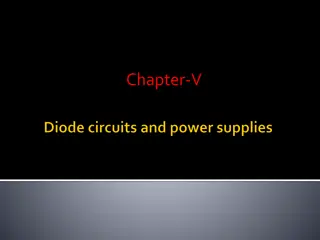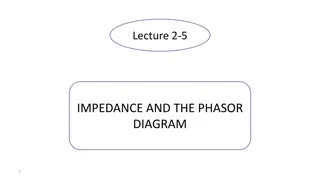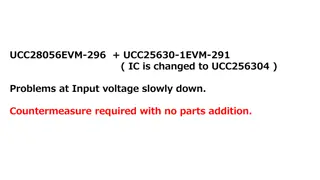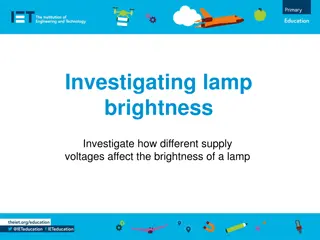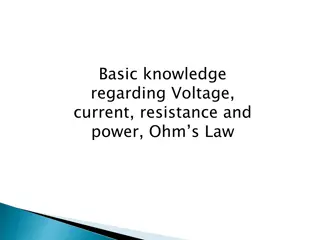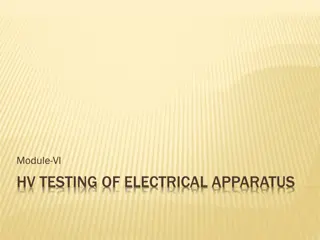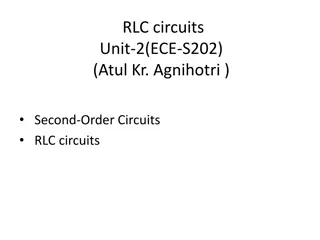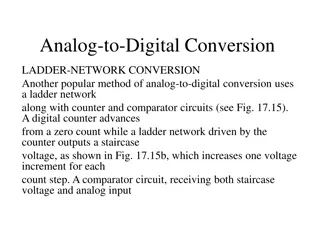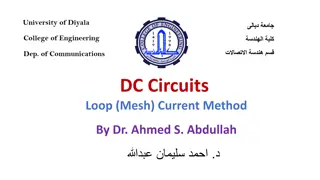Understanding Voltage and Electrical Potential in Physics
Explore the concepts of voltage, electrical potential, work, and charge through practical examples involving moving charges against electric and gravitational fields. Learn how to calculate voltage, work done, and gravitational potential changes in various scenarios. Dive into the world of electrica
3 views • 23 slides
AC Circuit Problems and Solutions
Explore various problems related to AC circuits, including calculations of current, voltage, reactance, impedance, and phase angles. Understand how to determine readings on ammeters and voltmeters, analyze inductor and capacitor interactions, and solve for circuit impedance with different components
0 views • 12 slides
Understanding Voltage Drop in Electrical Systems
Electrical calculations often focus on current or voltage drop to determine proper conductor sizes. Excessive voltage drop can lead to issues like flickering lights, poor heating, and overheating of motors, requiring attention to wire sizes and the National Electrical Code recommendations. Explore t
0 views • 20 slides
Understanding Electrical Quantities and Circuits in Physics
Explore the concepts of electrical quantities such as e.m.f., potential difference, resistance, current, and voltage in circuits. Learn about using voltmeters, measuring resistance, transferring energy in circuits, and understanding the relationships between these electrical properties. Delve into e
1 views • 65 slides
Understanding Voltage in Circuits: Effects and Applications
Explore the concept of voltage in circuits, its significance in electricity, and the effects of varying voltages on components like bulbs, motors, and buzzers. Discover how different voltage levels impact the brightness of a bulb, the loudness of a buzzer, and the overall performance of electrical d
0 views • 11 slides
Understanding Performance of Transmission Lines in Electrical Engineering
The performance of a transmission line in power systems is critical for efficient operation. Factors such as voltage drop, line losses, and transmission efficiency are key considerations in design and operation. The line parameters of resistance, inductance, capacitance, and shunt conductance play c
2 views • 26 slides
Understanding Electrical Circuits: Basics and Types
The presentation covers the basics of electrical circuits, explaining the concept of electric current, the role of cells and batteries, simple circuit components like switches and lamps, and circuit diagrams. It further delves into types of circuits - series circuits and parallel circuits, detailing
0 views • 24 slides
Understanding Bipolar Transistor Configurations for Electronic Circuits
Explore the three common configurations - Common Base, Common Emitter, and Common Collector - for Bipolar Transistors in electronic circuits. Each configuration offers unique characteristics such as voltage gain, current gain, and impedance levels, impacting the signal processing and amplification c
0 views • 27 slides
Understanding Electric Circuits and Solar Panels
Exploring the basics of electric circuits, solar panels, and the interplay between voltage, current, and resistance. Learn about series vs. parallel circuits, different types of current, and the principles behind photovoltaics. Discover how to wire loads/sources in series and the significance of vol
0 views • 18 slides
Understanding Feedback Amplifiers in Electronic Circuits
Feedback amplifiers play a crucial role in electronic circuits by providing mechanisms for controlling gain, stability, and overall performance. There are two basic types of feedback - positive and negative, each offering distinct advantages. The four ways of connecting feedback signals involve volt
0 views • 18 slides
Understanding Superposition Theorem in Electrical Circuits
Superposition theorem in electrical circuits states that the effects of multiple voltage and current sources in a network can be analyzed independently and then combined algebraically. This allows for calculating the voltage and current distribution in a network more efficiently. The theorem involve
0 views • 9 slides
Understanding Band-Gap Voltage References in Microelectronic Systems
Voltage references provide stable output voltages unaffected by variations in supply voltage, temperature, and process errors. This summary delves into the principles of band-gap voltage references and their crucial role in creating precise control voltages for ADCs, DACs, and various other applicat
1 views • 14 slides
Understanding Diode Circuits: Half-Wave Rectifiers and Full-Wave Rectifiers
Diode circuits play a crucial role in converting AC signals to DC signals. This article covers the basics of diodes, half-wave rectifiers, and full-wave rectifiers. It explains the functioning of unfiltered and filtered rectifier circuits, highlighting the differences in ripple effects and voltage r
6 views • 18 slides
Understanding Dynamic Voltage and Frequency Scaling in Advanced VLSI
Explore the concepts of Dynamic Voltage and Frequency Scaling (DVFS) in Advanced VLSI design. Learn about the impact on clocking, STA, and testing, as well as considerations for selecting the right voltage and frequency settings. Discover how controlling voltage affects power consumption and computa
0 views • 51 slides
Understanding Alternating Current and Voltage Waveforms
Alternating current and voltage exhibit specific waveform patterns such as sinusoidal waves. The sinusoidal waveform, including sine waves and harmonics, is fundamental in AC circuits. Sources like alternators produce sinusoidal voltages, while electronic signal generators create various waveforms f
0 views • 70 slides
Understanding Zener Diodes and Breakdown Characteristics
Zener diodes play a crucial role in electronic circuits by allowing current flow in both forward and reverse biased conditions. When reverse biased voltage is applied, zener diodes exhibit a unique behavior called breakdown, where a sudden rise in current occurs leading to zener voltage and zener cu
0 views • 21 slides
Understanding Zener Diodes for Voltage Regulation
Zener diodes are special diodes designed to have a low reverse breakdown voltage, making them ideal for voltage regulation purposes. When biased in the reverse direction, they provide a stable voltage output regardless of changes in current. This property can be effectively utilized to stabilize vol
0 views • 18 slides
Understanding Diode Circuits and Rectifiers for Power Supplies
Exploring the functionality of diode circuits in series and parallel configurations, along with clippers, clampers, and voltage multipliers. Gain insights into power supplies such as half-wave and full-wave rectifiers, Vrms derivation, Ripple Factor, and more. Learn about diode behavior in rectifica
4 views • 58 slides
Understanding Electrical Circuits and Ohm's Law
Electric circuits play a crucial role in our daily lives, powering various devices and appliances. This activity delves into Ohm's Law in parallel and series circuits, exploring the flow of electric current and the transformation of electrical energy into different forms. Through hands-on experiment
0 views • 31 slides
Understanding Impedance and Phasor Diagrams in AC Circuits
Resistive elements in AC circuits exhibit zero phase shift between current and voltage due to their angles. Inductors introduce inductance when connected to AC sources, generating magnetic flux that affects conductor charges. Faraday and Lenz's laws explain induced voltage and current direction base
0 views • 18 slides
Electrical Circuits: Understanding Voltage and Current
An overview of electrical circuits, including potential difference, current flow, voltage equations, and placement of measuring devices in circuits. Explore scenarios with images to test your knowledge of circuit principles.
0 views • 22 slides
Understanding Electric Circuits: Current, Voltage, and Resistance
Electric circuits involve the flow of electric current through conductors with varying levels of resistance. Current (I) is the amount of charge passing through a point in a wire per unit of time, measured in amperes. Voltage (V) is the potential difference required to make electrons flow in a condu
0 views • 25 slides
Understanding Circuits: Exploring Requirements, Function, and Analogies
Delve into the world of circuits by learning about their requirements, functions, and different types. Discover how circuits work, their components like bulbs and batteries, and explore analogies like comparing circuits to water parks. Gain insights into the flow of electrons and the essential laws
0 views • 47 slides
Exploring Circuits and Electrical Current: Essential Concepts and Experiments
Dive into the world of circuits and electrical current with a focus on understanding the requirements, components, and functioning of circuits. Explore essential questions, experiment with building circuits, and grasp the basics of how electricity flows through a circuit. Discover the different type
0 views • 54 slides
Understanding Input and Output Limitations in Op Amps
Explore the various input and output limitations in TI Precision Labs Op Amps as presented by Ian Williams and prepared by Art Kay and Ian Williams. Delve into common mode voltage, voltage swing, data sheet parameters translation, input and output stages, examples of common mode voltage, and potenti
0 views • 15 slides
Understanding Electric Circuits: Basics and Examples
An exploration of electric circuits, including their components, symbols, and the flow of current. Learn about examples of electric circuits used in devices like televisions and loudspeakers. Test your knowledge with questions on circuit symbols, the definition of an electric circuit, and examples o
0 views • 11 slides
Voltage Readings and Rules for Troubleshooting Wiring and System Issues
Data on voltage readings derived from bench testing in a controlled environment are provided as a reference for troubleshooting wiring and unit issues. General rules and guidelines for voltage measurements at various locations within the system are outlined, along with specific instructions for cont
0 views • 23 slides
Troubleshooting AC Input Voltage Variations in UCC28056EVM-296 and UCC25630-1EVM-291
Addressing issues with input voltage fluctuations in UCC28056EVM-296 and UCC25630-1EVM-291, where the voltage slowly decreases under different load conditions. Problems include output stopping at varying AC voltages based on load and hunching behavior at different load levels. Countermeasures are ne
0 views • 7 slides
Investigating the Relationship Between Supply Voltages and Lamp Brightness
This experiment explores how different supply voltages affect the brightness of a lamp by building circuits with varying battery configurations. By adjusting the voltage supply to the lamp, changes in brightness are observed, demonstrating the relationship between voltage and current flow in electri
0 views • 5 slides
Feedback Loop Compensation Design Using UCC28740 for Voltage Regulation
Explore the detailed design and control laws for a feedback loop compensation system using UCC28740 in a flyback regulator schematic diagram. The control law profile in CV mode, multiple control regions, and gain blocks are discussed for achieving high efficiency in voltage regulation. Gain blocks d
0 views • 16 slides
Applications of RC Circuits in Electronics and Biomedical Devices
RC circuits play a crucial role in various applications such as camera flashes, timing devices in automobiles, and heart pacemakers. These circuits involve charging and discharging a capacitor through a resistor, controlling voltage pulses for precise timing. In devices like camera flashes, the flas
0 views • 7 slides
Understanding Voltage, Current, Resistance, and Ohm's Law
Learn the fundamentals of voltage, current, resistance, and power, along with insights into Ohm’s Law. Discover how these concepts are interconnected and essential for understanding electrical circuits. Explore the unit of voltage, the movement of electrical current, the concept of resistance, and
0 views • 5 slides
Comprehensive Review of BJT CE Voltage Amplifier in Electronics Lab
This lecture provides a comprehensive review of the BJT CE voltage amplifier circuit, starting with theoretical concepts and moving towards practical implementations. It covers the operation of the BJT as a switch, the addition of resistors for current control, DC design considerations, AC voltage g
0 views • 19 slides
Understanding High Voltage Testing of Transformers
This detailed presentation covers the importance and procedures of high voltage testing for transformers. It highlights the purpose, objectives, tests involved, equipment used, and safety measures to ensure the reliability and longevity of transformers. Various tests like AC Withstand Voltage Test,
0 views • 7 slides
High Voltage Testing of Electrical Apparatus: Terminology, Test Facilities, and Procedures
Understanding general terminology in high voltage testing such as disruptive discharge, withstand voltage, flashover, and creepage distance. Explore the test facilities provided in high voltage laboratories and the different tests conducted on equipment like transformers, lightning arresters, and ca
0 views • 22 slides
Lower Bounds on Sampling Good Codes in Bounded-Depth Circuits
Bounded-depth circuits are proven unable to sample or approximate good codes effectively. This work delves into lower bounds, showcasing that bounded families of circuits face limitations in computing specific functions or sampling distributions. The example of Parity in AC0 circuits illustrates the
0 views • 21 slides
Understanding Second-Order RLC Circuits in Electronics
Explore second-order RLC circuits in electronics, characterized by second-order differential equations and involving resistors, inductors, capacitors, and voltage sources. Learn about initial and final values of voltage and current, applications in filters, and the differential equations governing t
0 views • 13 slides
Analog-to-Digital Conversion Using Ladder Network
Another popular method of analog-to-digital conversion involves the use of a ladder network in conjunction with counter and comparator circuits. In this method, a digital counter progresses from zero while the ladder network driven by the counter generates a staircase voltage pattern, incrementing b
0 views • 6 slides
Understanding DC Circuits: Mesh Current Method by Dr. Ahmed S. Abdullah
The DC Circuits Loop (Mesh) Current Method, explained by Dr. Ahmed S. Abdullah, applies Kirchhoff's Voltage Law (KVL) to find unknown currents in a circuit. This method involves assigning loop currents to loops, applying KVL to each loop, and indicating voltage polarities across all resistors based
0 views • 31 slides
Exploring Diode and Transistor Logic Circuits for LED Blinking and Logic Operations
Dive into the world of diode and transistor logic circuits with designs for NAND and AND gates, as well as LED blinking circuits using stable multi-vibrators. Learn how these circuits function and discover the components involved in creating a square wave generator. Explore the practical application
0 views • 9 slides
